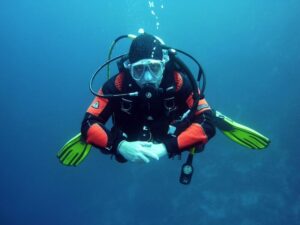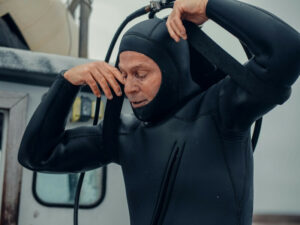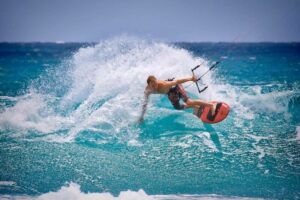Speed, finesse, and all powered by the collaboration of wind and waves. Kite surfing and windsurfing have a lot in common. They are THE most exciting and challenging ways to surf in the whole diverse surfing universe.
Every muscle in use, and every brain cell working to calculate the combined powers of the elements. But with all the similarities, it can get a bit complicated to tell those two peas in a pod apart. If you never ever want to have that problem again, we have just what you need! In the following guide, we will clarify the two terms and bring a spotlight to the difference between kitesurfing and windsurfing.
In this article, you will get answers to the following questions:
- Do many people struggle with the kitesurfing vs windsurfing difficulty?
- How does the equipment vary between kitesurfing vs windsurfing?
- What is the main difference between kitesurfing and windsurfing?
- Can one derive one surfing style skill from the other?
The Kitesurfing vs Windsurfing Difficulty – a Common Mistake
Both extreme sports, both essentially bound to wind and water and both involving speed, jumps up to several meters high, and adrenalin and concentration pouring from every pore of the rider’s body. There is no way of telling you which of the two is the better sport. But maybe after learning a bit more about these two sports, you will not only be able to tell them apart perfectly, but to decide yourself, which one suits you personally better as well. So let’s start by grasping the basic What is What of kitesurfing vs windsurfing.
Here are the main key points to compare kitesurfing vs windsurfing:
➀ History and Culture
➁ Power and Control
➂ Technique
➃ Equipment and Safety
➄ Learning Curve
➅ Mobility and Creativity
Kitesurfing vs Windsurfing: History and Culture
The world of water sports is steeped in rich histories and vibrant cultures, and two wind-powered activities, kitesurfing vs windsurfing, have distinct tales to tell. In this exploration, we’ll delve into the historical roots and cultural dimensions that have shaped these exhilarating water pursuits.
History of Windsurfing
Windsurfing, often regarded as a pioneer in wind-powered water sports, traces its origins back to the 1960s. In 1968, an American named Jim Drake and a British-born Hoyle Schweitzer collaborated to invent the original windsurfer, combining a surfboard with a handheld sail.
This innovative design paved the way for a rapidly growing global community of windsurfing enthusiasts. Throughout the 1970s and 1980s, windsurfing gained immense popularity, becoming an Olympic sport in 1984.
Windsurfing Culture
Windsurfing culture is deeply ingrained with a sense of freedom and adventure. Enthusiasts embrace the camaraderie of the windsurfing community, where sharing tips on technique and equipment is commonplace.
From recreational riders enjoying the thrill of gliding across the water to professional athletes pushing the boundaries of speed and tricks, windsurfing culture is as diverse as the windsurfers themselves.
History of Kite surfing
Kite surfing, a more recent addition to water sports, emerged in the late 20th century. In the late 1970s and early 1980s, various inventors experimented with using kites for propulsion on water.
However, it wasn’t until the late 1990s that the modern form of kite surfing took shape. The development of inflatable kites and dedicated kite surfing boards transformed it into the dynamic and adrenaline-pumping sport known today.
Kite surfing Culture
Kite surfing culture is characterized by a sense of thrill-seeking adventure and innovation. As riders harness the power of the wind with controllable kites, the sport has attracted those seeking new challenges on the water.
The kite surfing community is known for its creative spirit, pushing the boundaries of what is possible in the air and on the waves. From freestyle tricks to big air jumps, kite surfing culture embodies a daring and progressive ethos.
While windsurfing and kite surfing have distinct histories, they share commonalities in their evolution as wind-driven water sports. They influence each other, exchange inspiration and after all, share one passion: the love to surfing.
Kitesurfing vs Windsurfing: Power and Control
Harnessing the wind, riding the water. Both surf styles can be performed on the ocean’s surface, on lakes, even Rivers. Wherever there is wind and water, kitesurfing vs windsurfing can be practiced. But the big difference is, how the wind is being harnessed.
Kite Dynamics
At the heart of kite surfing is the majestic kite, a controllable wing that dances in the wind. Kite surfers manipulate the kite using a control bar connected by lines, harnessing the wind’s force to propel themselves across the water.
The kite becomes a dynamic partner, responding to the rider’s skillful inputs for speed, jumps, and gravity-defying tricks.
Kite surfing’s power source provides riders with unparalleled freedom of movement. The kite’s agility allows for swift directional changes, jumps that defy gravity, and the ability to ride waves with an unmatched sense of fluidity.
Sail Mastery
In the realm of windsurfing, the sail takes center stage as the primary source of propulsion. Windsurfers navigate the water by tilting and turning the sail attached to a mast, skillfully harnessing the wind’s force to propel themselves forward.
The sailor’s finesse in manipulating the sail and body weight dictates the board’s direction and speed.
Windsurfing’s power source integrates the rider’s control directly into the sail. By mastering the sail’s manipulation and understanding wind dynamics, windsurfers achieve a seamless dance with the elements. The sailor’s body movements become the direct order for the sail’s movements.
Kitesurfing vs Windsurfing: Technique
In the realm of kitesurfing vs windsurfing, techniques serve as the gateway to mastering the elements. Whether soaring through the air with a kite or elegantly gliding on a windsurfing board, riders navigate the waters with a blend of skill, finesse, and a deep connection to the ever-changing winds.
Launching
In kite surfing, you have got to lay out the kite with the leading edge facing the wind. Ensure the lines are untangled and the safety systems are functional.
As the wind catches the kite, use the control bar to guide it into the sky. Maintain control to prevent sudden movements and maintain a balanced stance, leaning back slightly to counteract the pull of the kite.
In windsurfing, on the other hand, you will want to position the sail perpendicular to the wind while holding the mast with one hand and the boom with the other. Allow the wind to fill the sail gradually, avoiding sudden movements. Step onto the board while maintaining control of the sail, keeping the nose of the board into the wind.
Controlled Movements
When it comes to board control, kitesurfing vs windsurfing, the biggest difference is, that a kite board needs foot straps, to ensure the rider stays on the board. In windsurfing, foot straps can be used, but are no necessity.
Because of that certain setup difference, kite surfing board control concentrates more on balance on the board, controlling the speed, and mastering edge control for turns and jumps. Windsurfing board control is all about shifting body weight, foot positioning, and tilting the sail to control the direction and speed of the board.
Kite surf riders manipulate the kite using a control bar, adjusting angles and power to control speed and perform tricks. And windsurfing requires mastering sail handling, understanding wind angles, and adjusting the sail for optimal speed and maneuvering.
Landing
When wanting to end your session, kitesurfing vs windsurfing require well-trained spot on techniques. In kite surfing, you will want to gradually steer the kite to the edge of the wind window to reduce power. Lower the kite gently to the ground while maintaining tension in the lines for control and activate the safety release system if needed for a quick depower.
In windsurfing, it is all about the positioning of the sail. Bring the board into the wind and reduce sail power by tilting it away from the wind. Step off the board while maintaining control of the sail. Secure the board with the foot leash and step out off the water.
Key Difference between Kitesurfing and Windsurfing Techniques
Kite surfing: Relies on controlling the kite’s lift for takeoff and descent. A controlled descent is crucial to avoid sudden drops.
Windsurfing: Involves controlling the sail’s catch of the wind for launch and skillful footwork for a smooth landing. The sailor’s body position is crucial for stability.
Kitesurfing vs Windsurfing: Equipment and Safety Essentials
Launching, jumping, turning, and landing. When the question is about the ‘what,’ there is a general consensus regarding kitesurfing vs windsurfing. But, when it comes to the ‘how,’ the two go separate ways.
The biggest reason for that, is the equipment. Not only, does one get their power from a kite and the other from a sail, but even the harness and the board come in different shapes and sizes.
The Board
The Kite surfboard usually comes in a smaller and more compact design. It often has foot straps or bindings to secure the rider’s feet.
Twin-tip boards are symmetrical, allowing riding in both directions without turning the board around. This design ensures that the rider can stay connected to the board at all times, regardless of the landing direction.
Depending on the riding style, specialized boards are available for specific disciplines like wake style or big air. The smaller the board, the easier the tricks up in the air and the more maneuverability the board brings the skilled rider.
Wind surfboards are generally larger and more buoyant. They can come equipped with foot straps or simply a deck plate to enhance the stability. Different board types cater to various windsurfing disciplines such as slalom, freestyle, wave, and longboards.
Kite vs. Sail
The most apparent differentiation in the whole kitesurfing vs windsurfing difficulty is the gear, used to harness the power of the wind.
The kitesurfing kite is typically inflatable and consists of a leading edge and struts that give it structure. Inflatable bladders provide buoyancy and shape to the kite when inflated.
They come in various sizes, typically ranging from 5 to 17 square meters. The size of the kite influences its power and performance, with smaller kites suitable for higher winds and larger kites for lighter winds. Just like for a surfboard, when adjusting the surfboard’s size to the size and power of the waves.
The kite is controlled by a control bar held by the rider. The control bar is connected to the kite by lines. Manipulating the control bar allows the rider to steer the kite, control its angle of attack, and adjust the power.
The windsurfing sail is typically made of durable materials such as monofilm, mylar, or a combination of materials like X-Ply. It is attached to a mast, which provides vertical support, and a boom, which the rider holds onto for control.
Tilting the mast and adjusting the position of the boom allow the rider to steer the board and control the speed. The size of the sail is selected based on wind conditions and the rider’s skill level.
Safety Mechanisms
The rider is attached to the kite through a harness. The kite harness distributes the pull of the kite across the rider’s body. Whether it is positioned around the waist or the chest is a personal decision, the rider can make based on their comfort and experience.
In windsurfing, the rider is connected to the sail through a harness. The harness helps distribute the forces exerted by the sail, reducing fatigue.
Windsurfing sails often feature adjustable downhaul and outhaul systems, allowing riders to tweak sail shape and control power. Understanding sail trim and utilizing safety measures, such as releasing the sail in strong winds, is essential for safety.
Kite surfing kites are equipped with safety systems, including quick-release mechanisms, to ensure the rider can depower the kite in emergency situations.
Emergency situations can happen any time, and understanding and practicing the use of the safety release system is crucial. Maintaining awareness of the kite’s and sail’s power and potential sudden changes in wind conditions can save you from unpleasant accidents.
Kitesurfing vs Windsurfing: Learning Curve
Starting a new hobby can be quite expensive. Not only moneywise, but in terms of time as well. When you only have ten days of holiday, you want to put as many crazy experiences, new skills and as much fun in as possible.
That leads to the big question: Kitesurfing vs Windsurfing. Which of those two offers the steeper learning curve, the bigger tricks, the higher jumps, and the biggest improvement in a limited amount of time?
In general, windsurfing is often considered more beginner-friendly than kite surfing. Learning to balance on the board and control the sail can be more intuitive for some beginners. Initial lessons focus on board skills, including getting on the board, steering, and sailing in a straight line. Learning to tack (turn into the wind) and jibe (turn downwind) are fundamental maneuvers.
Kite surfing has a steeper learning curve initially, primarily due to mastering kite control. Managing the kite’s power, steering, and safety systems requires focused attention.
Beginners often start with body dragging, which involves being pulled through the water by the kite. This phase helps build fundamental kite control skills before attempting board riding.
Transitioning to board riding involves combining kite control with board skills. Balancing on the board, water starts, and riding in different directions require coordinated movements. Proficiency in controlling the kite is crucial for a successful kite surfing experience. Riders need to learn to launch, land, and maneuver the kite effectively in various wind conditions.
Controlling the sail in windsurfing requires understanding how to manipulate the sail to catch the wind for propulsion. Sail control involves tilting the mast and adjusting body weight for steering. The learning curve for both kitesurfing vs windsurfing is part of the journey, and the choice between the two often depends on individual preferences and the desired level of challenge.
Kitesurfing vs Windsurfing: Mobility and Creativity
Ultimately, whether you prefer the artistic flair of kite surfing or the unique sail-driven creativity of windsurfing, is a personal decision. Kite surfing provides riders with unparalleled freedom of movement. The detached kite allows for dynamic and swift maneuvers, covering a wide area on the water.
The ability to catch air and perform jumps enhances the feeling of weightlessness, allowing riders to explore the three dimensions of the water.
Kite surfing is renowned for its emphasis on aerial tricks and freestyle maneuvers. Riders can unleash their creativity with spins, flips, grabs, and unique kite-driven moves. This versatility allows riders to explore different styles and express their creativity across various conditions.
Windsurfing’s mobility is closely tied to sail control. Riders manipulate the sail and use body movements to steer the board, providing a unique connection with the wind. Creativity in windsurfing often revolves around sail maneuvers. Riders can experiment with sail tilting, carving turns, and stylish jibes to showcase their personal flair.
Conclusion: What is the Difference between Kitesurfing and Windsurfing?
Kitesurfing vs windsurfing, while sharing the commonality of harnessing the wind for spectacular turns and jumps on the water, offer distinct experiences driven by their equipment, techniques, and the connection between rider and elements.
The learning curves of these sports mirror the diverse elements they harness. Kite surfing demands an initial mastery of kite control, offering a steep but thrilling ascent for those seeking a challenge. In contrast, windsurfing, often considered more beginner-friendly, invites enthusiasts to swiftly grasp sail and board control, providing a gentler initiation to the world of wind-driven water sports.
In the end, the decision for one or the other is the real kitesurfing vs windsurfing difficulty. But luckily, you are free to try out both and combine your next vacation not only with a jaw dropping surf spot visit, but maybe even with new hobbies to try out in the water.
FAQ – Most Asked Questions about Kitesurfing vs Windsurfing
The biggest key factor, that differentiates kitesurfing vs windsurfing, is the way the rider catches the wind. While kite surfers use a paragliding-like parachute, connected with meters long lines to a chest or hip harness, windsurfers hold a sail with their hands.
Yes, to some extent. Understanding wind dynamics is beneficial for both. Yet, kitesurfing vs windsurfing comes with a whole different set of equipment, techniques and ways to control the power of the wind.
Clearly, both come with a huge set of tricks and both do not depend on waves, such as other surf styles. Yet, due to the close connection to the sail, are windsurfers far more limited in their range of motion and mobility.
Kite surfing can have a steeper learning curve due to kite control. But in general, windsurfing is considered to be more beginner-friendly. Both should be tried out with a professional instructor for the first time!
Yes, both sports can be practiced in a range of wind conditions. Kite surfing allows for adaptability with different kite sizes, while windsurfers can choose sails based on wind strength. But make sure, to always prioritize safety and check the wind conditions before starting your surf.









